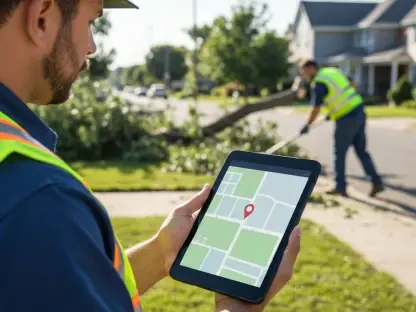Over time, as you install more apps, your Android phone starts to become cluttered. Finding specific apps among a plethora of installed ones can be cumbersome, making it imperative to have a system in place. There are a few things you can do to better organize installed apps on your phone and make it easier for yourself to find what you’re looking for. Below are some tried and tested methods to help you bring order to your app chaos, so explore them to see which ones suit your needs best.
1. Group Your Apps in Folders
Grouping your apps into folders is one of the most effective ways to organize your Android phone. This helps you categorize your apps and find relevant ones more easily. By creating folders, you can put all related apps in one place. For example, having a single folder for all your social media apps like Facebook, Instagram, Twitter, and Snapchat makes it convenient to access them without cluttering your home screen.
To create such a folder, access your home screen. Tap and hold the first app you want to categorize, then drag this app onto another relevant app. Android will create a folder and put both your apps in it. You can also pick apps from your phone’s app drawer to make app folders. Once your folder is created, to add more apps to it, simply drag and drop them into the folder. Android will automatically name the folder based on the type of apps you’ve added, but you can rename it by opening the folder, tapping the current name, and typing a new name.
If you need to remove an app from a folder, access the folder and tap and hold the app you want to remove, then drag and drop it outside the folder. Note that removing an app from a folder does not delete the app; it just places it back in the app drawer or on the home screen.
2. Pin Apps to the Bottom Dock
The bottom dock on your Android phone is valuable real estate where you can pin your most frequently used apps, allowing you to launch them from any home screen. This feature makes it easier to access your favorite apps without sifting through multiple screens.
To pin an app to this dock, find the app in your app drawer or home screen. Drag the app and drop it onto the dock. The app will remain there for easy access. Keep in mind that the dock can only accommodate a limited number of apps. If the dock is full, remove an existing app by tapping and holding it, then dragging it out of the dock.
This approach is beneficial for quick access to essential apps, especially those you use multiple times a day. By optimizing the use of your dock space, you streamline your workflow and reduce the time spent searching for applications.
3. Organize Apps in the App Drawer
Sorting your apps in the app drawer by various filters is another excellent method to keep your Android phone organized. This feature allows you to see your most important apps at the top, making it easier to access them.
To organize your apps, access your phone’s app drawer. From the top-right corner, select “Manage.” In the open menu, choose “Sort.” You’ll see a “Sort Apps By” panel. Here, you can choose to sort your apps by name, installation time, or most used. Once you’ve picked an option, Android will display your apps accordingly. If you ever want to go back to the default sorting method, you can do so by choosing that option in the panel.
Organizing your apps in the app drawer gives you a customized view, helping you find apps quicker without navigating through pages of icons. This system is particularly effective for those who have hundreds of apps installed on their devices.
4. Modify the Home Screen Grid Layout
Customizing the grid layout of your home screen can help you manage the number of apps visible, tailoring your screen to suit your needs. This feature lets you include more or fewer apps per screen, allowing for a less cluttered home screen.
To change the home screen grid layout, tap and hold on to an empty space on your home screen and choose “Layout” from the bottom bar. Choose the layout you’d like to have, such as 3 x 6, 4 x 5, 4 x 6, 5 x 5, or 5 x 6. Tap “Apply” after selecting a new layout to bring the change into effect.
Changing the grid layout not only enhances your phone’s aesthetic but also improves functionality by offering an organized view of your essential apps. This can result in a clutter-free home screen tailored to your preferences and usage patterns.
5. Add Widgets to Your Home Screen
Widgets offer a convenient way to access certain app functionalities directly from your home screen without having to open the app. For instance, the clock widget from the Clock app lets you see the current time without needing to open the application.
To add widgets to your home screen, tap and hold on a blank space and choose “Widgets” from the bottom bar. You’ll see a list of all available widgets for the apps installed on your phone. Tap and hold the widget you want to add, and then drop it onto your home screen. To remove a widget later, tap and hold on to it and choose “Remove.”
Widgets can significantly enhance your productivity by offering immediate access to essential information or functionalities. Common widgets include weather updates, calendar events, and note-taking. By strategically placing them on your home screen, you can optimize your user experience and save time.
6. Eliminate Unwanted Apps from the Home Screen
A cluttered home screen can be a source of frustration, and removing unwanted apps is a quick way to declutter. This method involves keeping the apps in your device while removing their shortcuts from the home screen.
To remove an app from the home screen, find the app, tap and hold it, and then choose “Remove.” In the prompt that appears, select “Remove.” This action only removes the app from the home screen, not from your device.
Following these steps to eliminate unwanted apps can give your home screen a cleaner look and make it easier to find the apps you use most often. If you ever want to add an app back to the home screen, simply drag it from the app drawer and drop it onto the desired home screen.
7. Stop Android from Adding New Apps to the Home Screen
By default, Android might automatically add new apps to your home screen upon installation. While this feature can be useful for quick access to newly installed apps, it can also lead to a cluttered home screen over time. If you prefer to keep your home screen tidy, you can turn off this feature.
To disable this setting, tap and hold on an empty area on your home screen and select “More” from the bottom bar. On the following page, turn off the “Add Apps to Home Screen” option. This action will ensure that new apps are only added to your app drawer, leaving your home screen as is.
Disabling this feature puts you in control of your home screen layout, allowing you to decide which apps deserve a spot there. This small but significant change can help maintain an organized and clutter-free home screen.
8. Lock the Home Screen Layout
Over time, as you add more apps, your Android phone inevitably becomes cluttered. This clutter can make finding specific apps among the multitude installed quite cumbersome. It’s important to implement an effective system to manage and organize your apps. Without proper organization, you may find yourself wasting valuable time searching for what you need. Fortunately, there are several proven methods you can use to bring order to the chaos on your phone.
One effective strategy is to create folders for your apps. By grouping similar apps together, you can significantly reduce the time it takes to find them. For instance, you might cluster all your social media apps in one folder and all your productivity tools in another. Another method involves sorting apps by frequency of use. Place the most frequently used apps on your home screen or in easily accessible locations, minimizing the time spent swiping and searching. Also, don’t overlook the importance of regularly deleting apps you no longer use, which not only declutters but also frees up valuable storage space.
You might also consider using a third-party launcher, which can offer additional organization features and customization options. Exploring these different methods will help you identify which system works best for your needs. With the right approach, you can turn your chaotic app collection into a well-organized digital toolkit, making your life easier and your phone more efficient.









